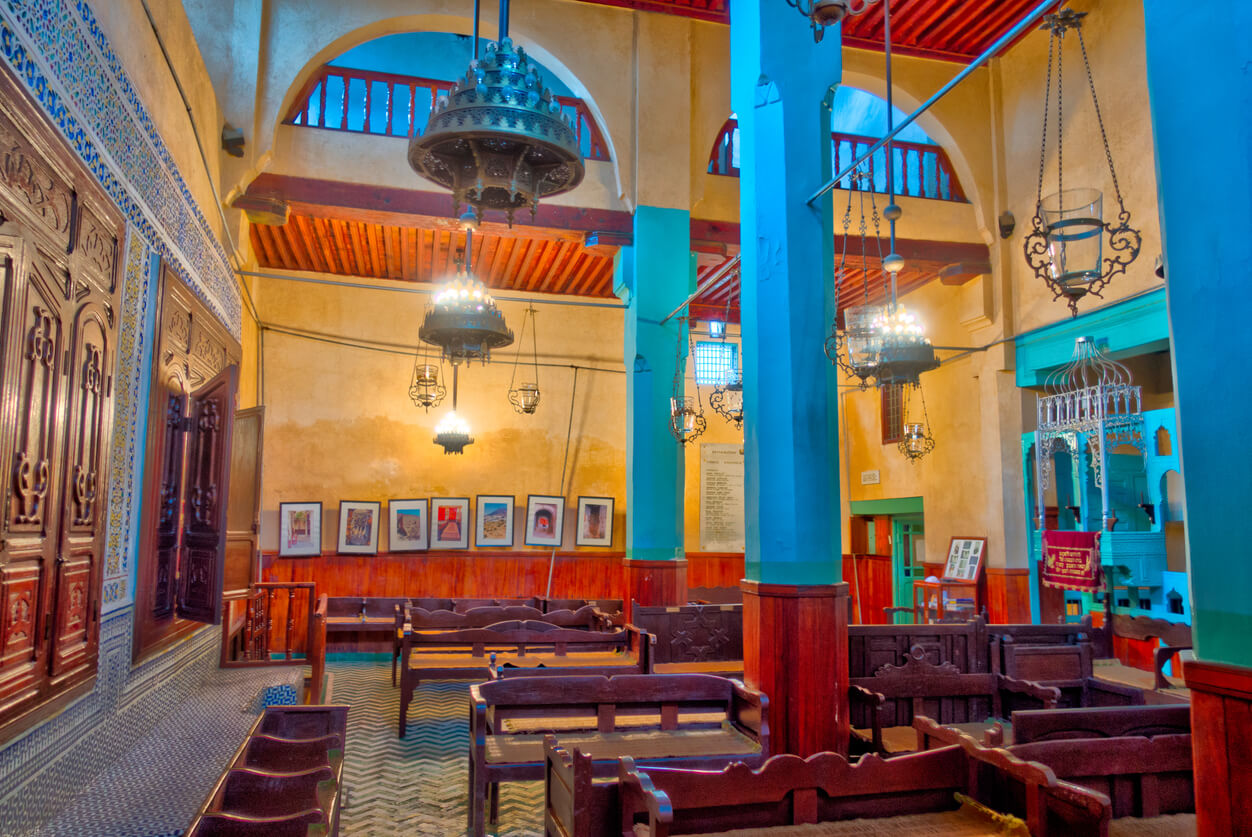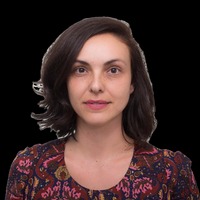Morocco’s Jewish golden era comes back to life

View of the interior of the Ibn Danan synagogue (Aben Danan synagogue) in the Jewish quarter of the Medina (old city) of Fez (Fes) in Morocco. Photo by iStock
This article originally appeared on Haaretz, and was reprinted here with permission. Sign up here to get Haaretz’s free Daily Brief newsletter delivered to your inbox.
After World War II, two Jews met in Casablanca and one said to the other: “Every Jew you meet here has some kind of project in the works, some idea they are ready to bring to fruition for the sake of their people and their language. They are starting a Hebrew club in Safi, tomorrow in Essaouira and in two days in some other city that are giving Hebrew lessons to the young and old.
“They’re starting a choir that will sing in Hebrew and building Hebrew-language schools. They’re composing Hebrew songs …. One of them is writing a Hebrew-French dictionary and another is writing textbooks for Hebrew schools. One is preparing a sermon for one Hebrew club and another, a speech for a different club.”
These remarks, which historian David Guedj cites in his book “Light in the West: Hebrew Culture in Morocco 1912-1956” (in Hebrew), reflect a high point in the flowering of Hebrew culture in the North African country. Even if the creative output of Moroccan Jews was relatively small, it included prose, nonfiction, poetry and translations that when combined amounted to a considerable body of work.
Furthermore, the complex assertion put forth in the book is that the blossoming of Hebrew language and culture in Morocco in the early and middle part of the last century was, in fact, a model for the organization and expansion of similar processes by Jews the world over.
Drawing on the theories of political scientist Benedict Anderson regarding imagined communities – which among other things explains the power of written words in creating a national consciousness – Guedj stresses that “the dissemination of texts in the Hebrew language to all the Jews of the Diaspora forged a sense of a single national identity and helped create an imaginary cross-border community that shares a language and a culture.”
In “Light in the West,” Guedj, an expert in Jews in Islamic countries who teaches at the Hebrew University of Jerusalem, recounts in detail an entire world of Hebrew culture in Morocco and resurrects this lost history through meticulous archival research. Among his sources are hundreds of letters written by Moroccan activists promoting the Hebrew language to people living in the Land of Israel, as well as other written materials, revealing a body of creative output that is at once touching, amusing, mundane – and historically significant.
Moroccan Jewry during the period under review was in the midst of a process of secularization that had begun in the 19th century but gained momentum at the start of the 20th as a Westernized elite emerged.
This elite for the most part was composed of graduates of various institutions affiliated with the Paris-based Alliance Israélite Universelle organization, which disseminated French language and culture. These Westernized Jews could travel outside Morocco thanks to the Alliance’s global network. They exchanged ideas, brought home new ideologies and adopted Westernization as cultural and symbolic capital.
But alongside French, Hebrew also spread among Morocco’s Jews via, among other means, newspapers and books that were brought into the country by merchants and immigrants. This made possible the emergence of a “textual network,” as Guedj calls it. Hebrew provided a way for Jews to connect with one another without their being affiliated with a certain place, by virtue of a shared national identity.
The educated Jews of Morocco, who lived primarily along the coast, in Casablanca and Tangiers, began writing for the Hebrew press in Europe at the dawn of the 20th century, providing in-depth stories on the life of their community.
One such writer was poet and scholar Rabbi Daṿid Elkaim of Essaouira, in western Morocco, who wrote for the journal Hatzfira (which was published in Warsaw). Like many other Moroccan Jews, he read the most important books and newspapers at the time, excelled at describing the experience of his country’s educated elite and demonstrated exceptional proficiency in the Hebrew language.
Elkaim – one of the creators of the canon of baqashot, or songs of supplication – is a “clear case of the shatnez created in Morocco,” writes Guedj (referring to a garment of mixed linen-wool cloth, banned by Jewish law) “that is not supposed to be worn, between the Enlightenment movement and the national movement, and within it the new Hebrew movement.”
In his book, the author examines the various institutions in Morocco that disseminated Hebrew and left behind extensive documentation. One of them was Or Hama’arav (“Light of the West”), printed in the Judeo-Arabic dialect, as well as Hebrew and French, and published in Casablanca from 1922 to 1923. Its publishers, brothers Shlomo and Avraham Hadida, also owned a small shop near the synagogue in the city’s Mellah (Jewish quarter).
Along with religious texts, the brothers sold Hebrew grammar books and textbooks, as well as newspapers from Palestine, Tunisia and Europe. The shop became a meeting place for rabbis, scholars, Hebrew teachers and well-educated people, most of them from the local Europeanized and Westernized community. The brothers’ bimonthly newspaper was translated into Judeo-Arabic with the aim of reaching readers who were not within the educated elite.
Clashing views of Judaism
World War II ushered in a dramatic change in Morocco’s Jewish community. Under Vichy rule, the few Jews who held public positions were fired, and they were banned from working in the free professions. Jews who lived in the European quarters of Moroccan cities were ordered to leave their homes and move to the Mellah.
As Guedj writes, “For the Europeanized and Westernized Jews the dream of integration was shattered.” After the war, the Zionist organizations that had established themselves in the country during the 1930s, and the Alliance Israélite Universelle, joined forces, now convinced that the national home of the Jewish people was in the Land of Israel. However, there were also clashing views of Judaism in Morocco, some of them opposed to the secular leanings that characterized the graduates of Alliance schools.
After the war, a Syrian-born Jew named Yosef Shama established a local educational network called Ozar Hatorah. Its goal was to use modern teaching methods to inculcate a religious Jewish identity, as opposed to a national or universalist one. In 1951,the first emissaries of the Chabad movement arrived in Morocco and in a few years, with the consent of the community’s rabbis and other leaders, it set up a series of educational institutions, which included yeshivas in the cities, as well as seminaries for girls and Talmud Torahs for boys in outlying areas.
According to Guedj, Chabad brought Orthodoxy to Morocco. Its institutions could be found in over 50 villages, many of them isolated, in the southern part of the country, in locales where the Alliance had never established itself. In contrast to Ozar Hatorah and the Alliance, Chabad employed a conservative religious approach in educating students and teachers alike. Its curriculum focused on sacred sources and Hebrew texts. The advent of the movement marked the birth of ultra-Orthodoxy in Morocco.
During those same years, Jewish communities around the world were engaged in a heated debate over the nature of Jewish education. The situation of Western European Jewry after the Holocaust worried many community leaders, and their response was to emphasize the value of a traditional Jewish education. Guedj says these same concerns were shared by Westernized and Europeanized Jews in many communities throughout the Islamic world.
Actually, as early as 1916, Moroccan journalist Haim Toledano wrote that religion was losing its power to bind together the local Jewish community, especially among the young generation who had been educated in Alliance schools. Many of the Westernized Jews of Toledano’s generation didn’t want to give their children a religious education, and yet they also didn’t want to make a complete break with religion. Instead, they sought to add more Torah-related and Hebrew content into the Alliance Israélite Universelle curriculum.
‘Civilizing mission’
Nevertheless, the Alliance never really tried to integrate the culture of Moroccan Jewry – with its traditionalist character – with Western culture. To the contrary, it promoted the latter and in many ways sought to Westernize the Jews of the Islamic world in general. The network’s leaders condemned the traditional Jewish practices that were passed down from generation to generation and the multitude of rituals, which they considered superstitious.
For his part, Guedj writes that the Francophone Alliance also looked down on Arabic language and culture, and as a result did not use Judeo-Arabic in its institutions. He asserts that Alliance educators were influenced by the organization’s “civilizing mission,” but not always for the better. At its training institution in Casablanca, future teachers learned about the Zionist culture of the workers in the Land of Israel and about kibbutzim, public health services, and leaders and cultural luminaries including Ze’ev Jabotinsky, Shaul Tchernichovsky, Rachel Bluwstein, Haim Nahman Bialik and Ahad Ha’am. They also learned about the history of the Jewish people – but were taught nothing about that of the Jews of Morocco.
In spite of the powerful Western cultural thrust, Zionist elements from Europe and the Land of Israel didn’t succeed to gain a foothold over Morocco’s Jewish leadership; indeed, they were marginalized by representatives of the broader community.
In Morocco, as in much of the Islamic world, Hebrew culture took root along with traditional Jewish-religious culture. A secular culture didn’t develop there as it did in Europe. Hebrew wasn’t taking root just in schools and the press, but also in synagogue worship. “Choirs sang at Oneg Shabbat gatherings, essays were written for literary competitions in Hebrew classes, and Hebrew plays were staged on holidays,” Guedj writes.
Thus, for example, Rabbi David Buzaglo, the great 20th-century composer of piyyutim (liturgical poetry), was considered a star at the Casablanca “Language Lovers” club – an association involved in spreading Hebrew language and culture. Many of his speeches and poetry, put to melodies of the popular singer Abd al-Wahhab among others, reflect a natural integration of the popular with the sacred, and the traditional with the modern. This synthesis characterized the Jews of Morocco and helped disseminate Hebrew language and culture among the masses.
“Light in the West: Hebrew Culture in Morocco 1912-1956,” by David Guedj, Zalman Shazar Center, 389 pages (Hebrew).

I hope you appreciated this article. Before you go, I’d like to ask you to please support the Forward’s award-winning journalism this Passover.
In this age of misinformation, our work is needed like never before. We report on the news that matters most to American Jews, driven by truth, not ideology.
At a time when newsrooms are closing or cutting back, the Forward has removed its paywall. That means for the first time in our 126-year history, Forward journalism is free to everyone, everywhere. With an ongoing war, rising antisemitism, and a flood of disinformation that may affect the upcoming election, we believe that free and open access to Jewish journalism is imperative.
Readers like you make it all possible. Right now, we’re in the middle of our Passover Pledge Drive and we still need 300 people to step up and make a gift to sustain our trustworthy, independent journalism.
Make a gift of any size and become a Forward member today. You’ll support our mission to tell the American Jewish story fully and fairly.
— Rachel Fishman Feddersen, Publisher and CEO
Join our mission to tell the Jewish story fully and fairly.
Only 300 more gifts needed by April 30
























